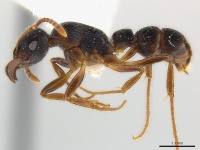Gnamptogenys curvoclypeata
| Gnamptogenys curvoclypeata | |
|---|---|

| |
| Scientific classification | |
| Kingdom: | Animalia |
| Phylum: | Arthropoda |
| Class: | Insecta |
| Order: | Hymenoptera |
| Family: | Formicidae |
| Subfamily: | Ectatomminae |
| Tribe: | Ectatommini |
| Genus: | Gnamptogenys |
| Species: | G. curvoclypeata |
| Binomial name | |
| Gnamptogenys curvoclypeata Lattke, 1990 | |
Nothing is known about the biology of Gnamptogenys curvoclypeata.
Identification
A member of the sulcata complex (in the sulcata subgroup of the sulcata species group). Piceous species with ferruginous antenna, legs and coxae; Promesonotal suture very weakly impressed, visible only with certain angles of light; meso- and metacoxae smooth and shining on median and basal lateral faces; metacoxae with weakly developed triangular dorsal lobe. (Lattke 1995)
Keys including this Species
Distribution
Latitudinal Distribution Pattern
Latitudinal Range: 9.683° to -5.997222222°.
| North Temperate |
North Subtropical |
Tropical | South Subtropical |
South Temperate |
- Source: AntMaps
Distribution based on Regional Taxon Lists
Neotropical Region: Colombia, Venezuela (type locality).
Distribution based on AntMaps
Distribution based on AntWeb specimens
Check data from AntWeb
Countries Occupied
| Number of countries occupied by this species based on AntWiki Regional Taxon Lists. In general, fewer countries occupied indicates a narrower range, while more countries indicates a more widespread species. |

|
Estimated Abundance
| Relative abundance based on number of AntMaps records per species (this species within the purple bar). Fewer records (to the left) indicates a less abundant/encountered species while more records (to the right) indicates more abundant/encountered species. |

|
Biology
|
Castes
Nomenclature
The following information is derived from Barry Bolton's Online Catalogue of the Ants of the World.
- curvoclypeata. Gnamptogenys curvoclypeata Lattke, 1990b: 9, figs. 7, 13 (w.) VENEZUELA.
- Type-material: holotype worker, 21 paratype workers.
- Type-locality: holotype Venezuela: Estado Portuguesa, via Guanare-Biscucuy, Quebrada La Guata, 9°16’N, 65°56’W, 600 m., 21.viii.1983 (J. Lattke & J. DeMarmels); paratypes: 19 workers with same data, 2 workers Venezuela: Estado Zulia, Serranía de Perija, El Tucuco, 9°41’N, 72°45’W, 450 m., 6.ix.1984 (J. Lattke).
- Type-depositories: MIZA (holotype); BMNH, FSCG, LACM, MCZC, MIZA, MZSP (paratypes).
- Status as species: Brandão, 1991: 344; Bolton, 1995b: 209; Lattke, 1995: 165; Lattke, et al. 2004: 343; Lattke, et al. 2007: 262 (in key); Lattke, et al. 2008: 84; Feitosa & Prada-Achiardi, 2019: 671; Camacho, et al. 2020: 460 (in key); Camacho, Franco, Branstetter, et al. 2022: 11.
- Distribution: Colombia, Panama, Venezuela.
Unless otherwise noted the text for the remainder of this section is reported from the publication that includes the original description.
Description
References
- Lattke, J. E. 1990b. Revisión del género Gnamptogenys Roger en Venezuela (Hymenoptera: Formicidae). Acta Terramaris 2: 1-47 (page 9, figs. 7, 13 worker described)
- Lattke, J. E. 1995. Revision of the ant genus Gnamptogenys in the New World (Hymenoptera: Formicidae). J. Hym. Res. 4: 137-193. PDF
- Lattke, J.E., Fernández, F. & Palacio, E.E. 2007. Identification of the species of Gnamptogenys Roger in the Americas (pp. 254-270). In Snelling, R.R., Fisher, B.L. & Ward, P.S. (eds). Advances in ant systematics: homage to E.O. Wilson – 50 years of contributions. Memoirs of the American Entomological Institute 80: 690 pp.
References based on Global Ant Biodiversity Informatics
- Brandao, C.R.F. 1991. Adendos ao catalogo abreviado das formigas da regiao neotropical (Hymenoptera: Formicidae). Rev. Bras. Entomol. 35: 319-412.
- Donoso D. A. 2014. Assembly mechanisms shaping tropical litter ant communities. Ecography 37 doi: 10.1111/j.1600-0587.2013.00253.x
- Fernández, F. and S. Sendoya. 2004. Lista de las hormigas neotropicales. Biota Colombiana Volume 5, Number 1.


